- Home
- Tucson Climate
Climate in Tucson AZ
Tucson Weather Guide for the Best Times to Visit
The climate in Tucson AZ is particular to the Sonoran Desert.
Even though the Köppen climate analysis tells us it's a hot desert, don't let that scare you off! Plenty of us live here, enjoying what's probably the sunniest city in the U.S. And we wouldn't live anywhere else!
Yes, summers are normally scorchingly hot! But we Tucsonans manage that. Winters are mild, and very enjoyable. Spring and fall have their own unique patterns.
And even though it's a desert, we get rainfall during two distinct seasons: winter storms and the North American Monsoon.
Lets see what you need to know.
Seasonal Highlights for Tucson's Climate
FTC Disclosure: If you purchase via a link/ ad on this site, we may earn a small royalty. There's no added cost to you. Thanks much for any looks/ orders! Details>
Despite what some say, Tucson does have seasons.
They're the Sonoran Desert's own unique seasons. Each has its differences. You'd notice the changes with this wonderful video.
Called Desert Dreams Celebrating Five Seasons in the Sonoran Desert. With 52‑minutes of stunning HD and time‑lapse footage. You'll see the five distinct seasons (Dry Summer, Wet Summer, Autumn, Winter, Spring) we experience in the Tucson area.
Let's now begin by seeing what autumn holds for visiting Tucson Arizona.
Why You Should Visit Tucson in the Fall
Fall climate in Tucson AZ offers a welcome escape from the summer heat, making it a popular season for traveling to Tucson.
Great for outdoor activities with moderate temps and fewer storms. Yet September can still have warmer days than you'd probably want.
Instead plan for October and November! You'll often have ideal daytime temperatures from 70oF/21oC to about 80oF/26.7oC. And remember once the sun sets, temperatures can drop as much as 10oF/7oC. It's our favorite time of the year.
It rarely rains in the autumn, so dry sunny weather is the expectation. You'll get near-perfect weather for many outdoor activities.
- Like biking The Loop - which USA Today entitled "Number One Bike Path in America."
- Like relaxing on outdoor patios - perhaps at A Tucson Restaurant.
- Like hiking in Saguaro National Park, for its Memorable Scenery.
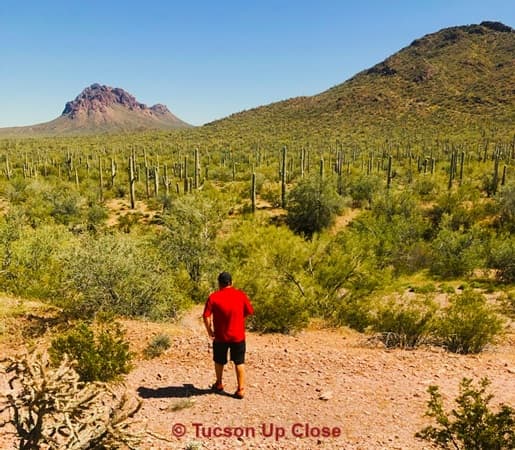 Our son-in-law walking an easy part of Saguaro National Park.
Our son-in-law walking an easy part of Saguaro National Park.During the autumn you'll even be able to see more unique, fun experiences. Such as major cultural events like Tucson Meet Yourself and the All Souls Procession.
Instead winter may be your best choice. Let's find out!
Enjoy a Mild Winter in Tucson Arizona
If you're flexible for planning a trip to Tucson, this is the best.
The climate in Tucson AZ in winter-time means mild, sunny days which everyone who lives here loves. The temperature averages 65°F/18°C. As is the case in a desert it cools down more after the sun sets. Temps drop pretty quickly, generally down to between 40°F/4°C and 50°F/10°C.
For sure it's the perfect time for outdoor activities like hiking, bicycle riding, golfing, and Exploring Parks in the Desert.
Winter humidity is low, hovering anywhere between 30-40%. The average humidity all winter is about 35%. We have a home "weather station" which I love viewing each day. On occasion in winter, I've seen humidity as low as 10%.
To prepare for winter weather in Tucson, we recommend packing a light jacket or sweatshirt. I'm not cold-tolerant and often get by layering. First a shirt and topping that with a sweatshirt.
Yet, you'll see many around town wearing shorts and a short-sleeve shirt. It could be they're our winter-stay visitors, who are used to colder averages in their native state or country.
On occasion, the winter climate in Tucson AZ brings a winter storm from off the Pacific. Not too often, though. Even a snowstorm (like the last time it snowed in the city: March 2, 2023).
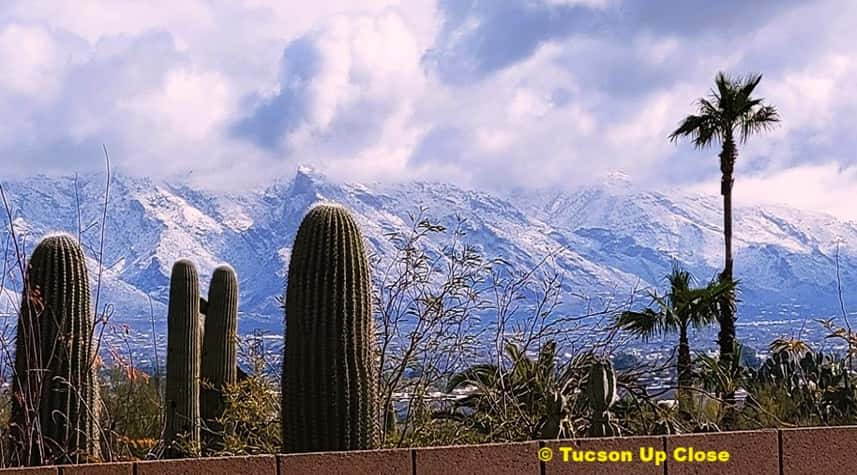 If it snows, most of it occurs in surrounding mountains. Like on this winter day.
If it snows, most of it occurs in surrounding mountains. Like on this winter day.Plan Your Winter Trip to Tucson today!
With low humidity and minimal chance of rain, winter is the ideal weather climate in Tucson AZ for travelers. But many think Spring may be a great time to visit Tucson.
Is it?
Is Now the Time to Visit Tucson?
Our Spring Weather Guide
Many people who don't live in Arizona, feel that spring must have ideal conditions for exploring Tucson.
We don't really agree with that feeling. Yes, daytime temperatures range from 70-85°F/21-26.7oC. Plus it's really unlikely to have rainy weather.
But there are drawbacks. Let's see those, as well as the benefits
Climate in Tucson AZ Drawbacks
for a Springtime Visit
When winter's over, people everywhere often look forward to swimming in nearby lakes or city pools. Plus a choice of other things to do as the weather gets warmer, but still not too hot.
We see it a different way.
From years of experiencing springtime in Arizona, we find that Spring is the windiest time of year. Annoyingly so! (Unless, of course you enjoy wind.) I know that's not exactly a scientific analysis.
At this time of year, I've seen our television weather forecasters explain the Jet Stream wind patterns from the West Coast coming across.
- As spring begins, the upper-level winds start getting more northerly.
- That brings rainy weather systems north of Arizona. Into Utah, for instance.
- Plus, this creates pressure gradients dragging dry wind to the south, to Arizona!
Lately it seems to be getting worse, it's windy just about every day. We rarely go outdoors then.
Climate in Tucson AZ
Advantages for a Springtime Visit
But you still may want to give it a go, because...
- March through May you'll find the Sonoran Desert is blooming with colorful desert wildflowers! The more winter rains, the more flowers!!
- Plus the saguaro cacti flowers open through May.
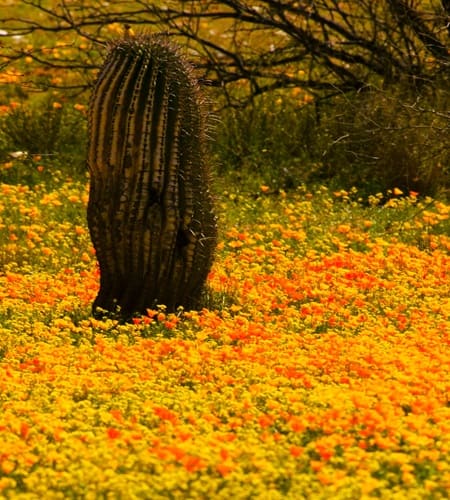 California Poppy - Eschscholtzia californica.
California Poppy - Eschscholtzia californica.AKA Mexican Gold Poppy, growing up in spring.
- In early spring you'll still have pleasant temperatures. Evenings after sunset have temps cooling into the low 60s-70sF/15.6-21C. Making patio dining comfortable. Windy conditions dwindle. And you're avoiding the summer heat-up.
- Clear skies provide excellent stargazing opportunities. The time of the year with the lowest yearly average rainfall.
- You'll avoid winter crowds, for a better authentic Tucson experience. As winter's the most popular time to visit.
Now, would you even think to experience the Sonoran Desert summer?
Summer in Tucson AZ Can Be Brutal!
These specifics will help you see how the summertime climate in Tucson AZ can turn out. If you decide to visit.
Overall, June is usually the hottest month. The record high of 117°F/47.2°C was set in June - the 27th of 1990. We remember that day! We had to take care of an outdoor project that couldn't wait. 🥵
The end of May into June, and sometimes into July get average highs in the 100°F/37.8°C range. Overnight normal lows have gone down to 71°F/21.7°C. Though lately have stayed higher.
Locals manage the Tucson summer, to endure!
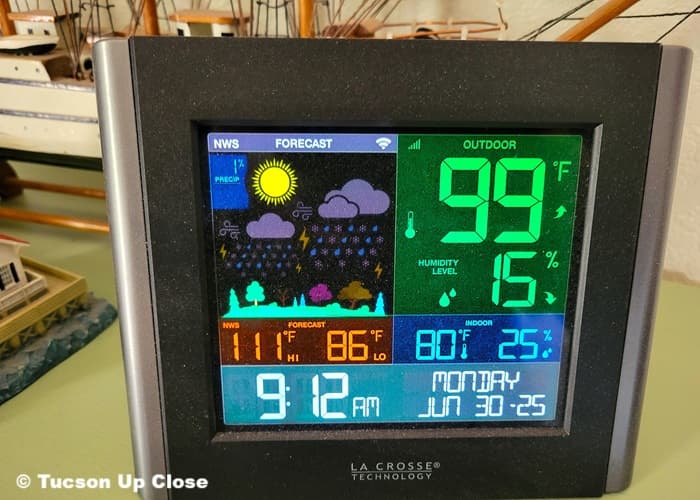 Note the time of day, the morning already 99! 37.2 Celcius.
Note the time of day, the morning already 99! 37.2 Celcius.Tucson Arizona Monsoon Season
But then Monsoon Storms arrive.
For a number of years now, (I don't know why!) local weather TV broadcasts insist it begins mid‑June.
People who have lived here awhile believe it actually begins on the 4th of July, give or take a couple of days. It's what we've mostly seen over the years. And most locals love when it begins!
Temperatures can drop as much as 20oF/11oC, within the first half-hour of some good rain. It's more cloudy, which tempers the sun's heating effects.
With the Monsoon in Tucson AZ, it gets more humid. But only up to about 20-30%, or more with late‑afternoon thunderstorms. We remember going back East, where the humidity was 95% in summer, and we were very uncomfortable.
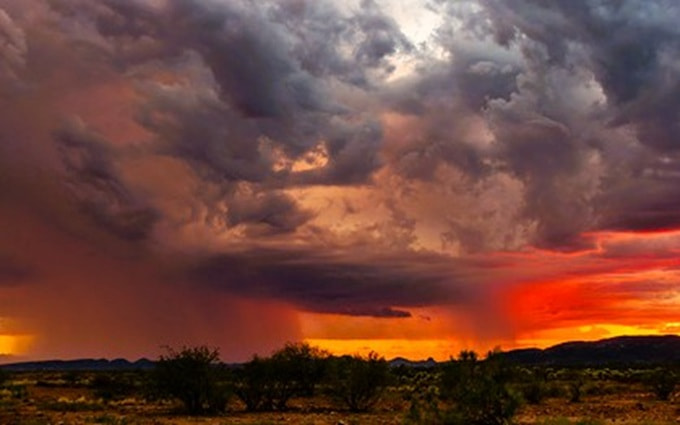 Nearing sunset, a Monsoon storm in the distance in the Sonoran Desert
Nearing sunset, a Monsoon storm in the distance in the Sonoran DesertClimate in Tucson AZ - the Extremes
Here's how NOAA (The National Oceanic and Atmospheric Administration) crunches the numbers for reporting the averages for extremes of the climate in Tucson Arizona.
- Daily Average Calculation: A day's average is figured by taking the daily minimum and maximum temperatures and dividing by 2.
- Annual Average Calculation: The year's averages are computed by getting all 365 daily averages and dividing by 365.
Then for historical data, their results are done this way:
- Take each year's average using the method above.
- Then view individual years to identify records and extremes.
- The full historical record (at this time usually from 1894-2025) is used to see all-time extremes.
 Figuring out the science calculations!
Figuring out the science calculations!To read more details see:
- www.climate.gov/maps-data/climate-data-primer/how-do-weather-observations-become-climate-data
- To research historical climate records: www.ncei.noaa.gov/cdo-web/
The Hot Tucson Weather Extremes
For our climate in Tucson AZ info, we're showing you the extreme records since 1894 through 2022, unless we note otherwise.
As I mentioned above, the record high of 117°F/47.2°C was on June 27, 1990.
- Historically the warmest year was in 2017. The average temperature is calculated to 73.3oF/22.9oC.
- The warmest month was August 2020. The temperature average was 92oF/33.3oC.
- The National Weather Service, Tucson Bureau, issues Extreme Heat Warnings. Most of us, as residents, realize the uncomfortable feeling if we need to go outdoors. These warning use an Index for Risk Evaluation. Weather factors are combined with the possible human health effects.
In Tucson, we average about 158 days/year at or above 90°F/32.2oC. That's based on the 1991-2020 climate normals from NOAA.
Sunlight & Sunshine - The Facts for Tucson!
Annual daylight averages about 10.4 hours. It peaks at around 14 hours in June. Oh, June - we really don't want all that sun at that time of year!
Because of the regularly high UV exposure in our desert, it can bring health risks. Note that skin cancer rates in Arizona are approximately three times the U.S. national average.
Cold Tucson Weather Extremes
Yes, we've had extreme cold (our local version), but we don't get very cold very often!
The record low was 6°F/-14oC on January 7, 1913. Well, I don't remember that one! I wasn't yet upon the earth. 😉
Only about 12 days/year the average temperature lowers at to 32°F/0oC, or below. But the advantage we have here is a short trip to sample it, by visiting Summerhaven up on Mount Lemmon!
Two of the coolest years occurred in 1905 and 1912. When the temperatures averaged 65oF/18.3oC. Historically the coldest month of all for the climate in Tucson AZ was January 1937. The temperature averaged 41oF/5oC.
Precipitation Extremes in Tucson AZ Weather
When NOAA quotes data for precipitation, it includes both rain, drizzle and snow. Plus any types of water particles falling from the sky and reaching the ground.
So that includes sleet, hail, and freezing rain - all of which are extremely rare in Tucson.
Precipitation weather Records for Tucson
Precipitation extreme facts for Tucson are:
- Recorded over 24 hours, the one-day total was 3.93in/9.98cm on July 29, 1958.
- The wettest year was 1905, formulated at 24.17in/61.39cm.
- The wettest month occurred in July 2021, with 8.06in/20.47cm of precipitation.
- Then at the other end of the spectrum are the driest times:
- Over the year in 2020 precipitation totaled just 4.17in/10.59cm.
- The driest month recorded was May 2022 with no precipitation all month. Since May is the driest month of the year, on average, there were 102 prior May months when there was no precipitation.
- With less than 0.2in/0.508cm, spring & early summer averages the driest time of the year.
Did you notice the wettest month was July? The time of summer monsoons, when we get the most average rainfall within a year.
- The average monsoon totals peak during July, with about 2.2in/5.588cm of rain.
- The monsoon continues into August, averaging about 2in/5.08cm.
- Usually there's about 8-9 days of rain for each month.
- Yet I remember one year when the monsoon brought days and days of rain. So much that the Santa Cruz River overflowed its banks!
We have another rainy season in the winter, when Pacific storms arrive. But their average rainfall doesn't equal monsoon months.
Now let's check the actual precipitation by snowfall in Tucson.
Snowfall Records in Tucson Arizona
Snowfall is pretty rare here in Tucson, especially for the desert floor.
When it happens, it doesn't last long. I remember, though, seeing one White Christmas, and one Easter snowfall.
The measurements are taken in areas in town, and don't include the local mountains.
- The one-day record happened on December 8, 1971. Recorded over 24-hours, it totaled 6.8in/17.27cm.
- The yearly record totaled 8.3in/21.08cm, which happened in 1987
Climate Change & Mega‑Drought
NOAA state by state climate summaries show that Arizona has been warming 2°F/1.1°C over past century.
Heat waves are intensifying, becoming more intense with increased duration. Especially so in urban areas around Tucson and Phoenix, because of the Heat Island Effects.
- In fact, Tucson had its longest consecutive run of temperatures at or above 100°F/37.8oC It lasted 53 days, from June-16 to August-7 in 2023
- Phoenix had its longest-ever run of triple-digit temperatures in 2024. Residents endured 113 consecutive days of 100 degrees & up.
Climate in Tucson AZ - Visitor Tips
Best times to visit: Mid‑October to the end of February.
Hydration & sun protection essential year‑round. But especially during spring and summer.
In summer, pay attention to extreme heat warnings, which are published to deter risk-taking and to keep people safe. Never go hiking at such a time. People die or suffer heat stroke and need to be rescued every year! Better to note the warnings.
Prepare for afternoon monsoon storms in summer. Rain can come in hard and fast, causing flash‑floods. They also might create an advance dust storms.
Be aware of the roadway dips, which shouldn't be crossed in running water. Every year people drive in and get stuck, sometimes needing rescue! When first responders help, there's a fine, along with paying the costs. This, due to our "Stupid Motorist's Law" (AZ Revised Statute 25-10).

Takeaways for Climate in Tucson AZ
Tucson’s climate is defined by sunny skies, hot summers, mild winters, and distinct rainfall seasons.
Its desert landscape and regular sunshine make it unique, but bring challenges.
- Heat exposure, monsoon storms, drought, and wildfire risk are all climate related.
- Visitors and residents should be aware of the climate in Tucson AZ.
- With this knowledge, they can balance enjoyment of its beauty with preparation for extremes.